Want to maximize your edible-garden yields? Many vegetable gardeners are thinking
inside the box and planting square-foot gardens. Different from traditional garden rows, this design system makes it easy to enjoy intensively planted harvests within a small space.
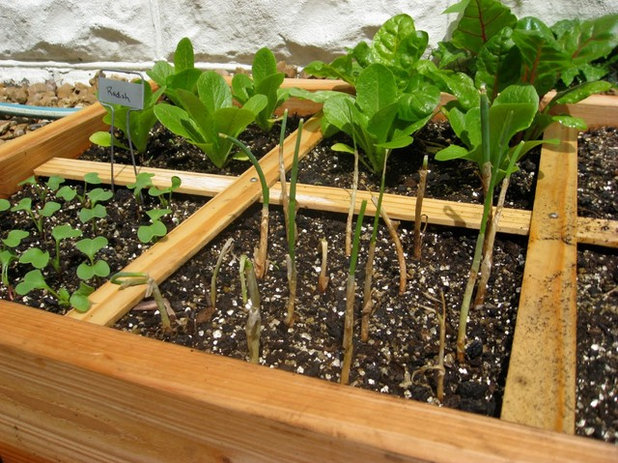 Square-Foot Gardening 101
Square-Foot Gardening 101Developed by Mel Bartholomew with the publication and broadcasting of his 1981 book and PBS series,
Square Foot Gardening (updated in 2006 with the publication of
All New Square Foot Gardening), this method has been a popular choice for home gardeners who wish to get the most out of small spaces. In this system, raised beds are filled with compost-rich soil and are topped off by a grid that sections the bed into 1-foot squares. Each square is then sown with a different type of seed. After each section is harvested, the soil can be replanted with a new crop.
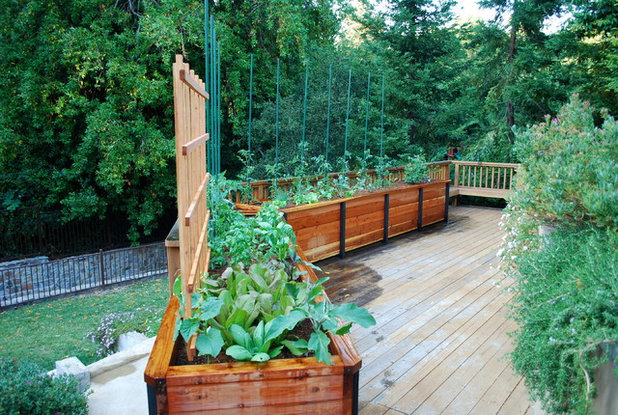
Steve Masley Consulting and Design
Growing plants vertically to save space is another principle advocated by square-foot gardening. Many square-foot gardeners fit their beds with a trellis at one end, allowing climbing plants like peas, tomatoes, beans and cucumbers to grow up rather than out.
Combined, these techniques create ideal conditions for intensive, easy-to-manage small-space gardening. Because the raised beds are filled with rich soil and are never stepped on, gardens tend to stay in good condition for longer than with other techniques. The square-foot design makes it easy to harvest just the right amount for a daily salad. The patchwork design encourages plant diversity and companion planting while creating an attractive appearance.
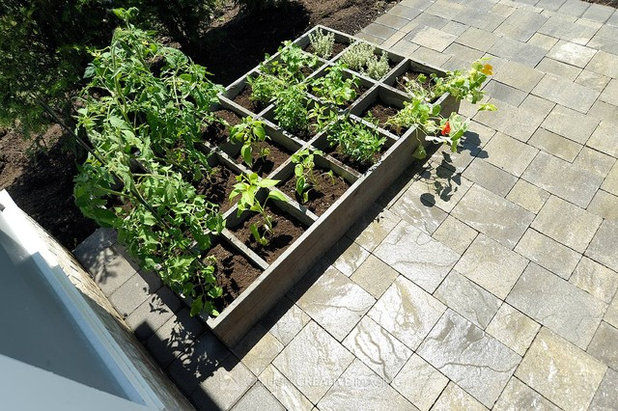
Weaver Custom Homes
Making Square-Foot Gardening Work for YouRaised beds. Over time, gardeners have adapted the original principles of square-foot gardening to suit their individual needs. Generally speaking, square-foot gardens start out with a wood-framed raised bed. It’s important to ensure that your bed is deep (ideally at least 1 foot), strong and level. Use untreated cedar or another garden-safe material to construct your bed. Built correctly, a raised bed can stay in shape for years.
Ensure that your bed is a size that allows you to easily reach all parts, including the center. In most cases, 4 by 8 feet is ideal. Consider building a trellis at one end and installing pipe holders for row covers.
8 Materials for Raised Garden Beds
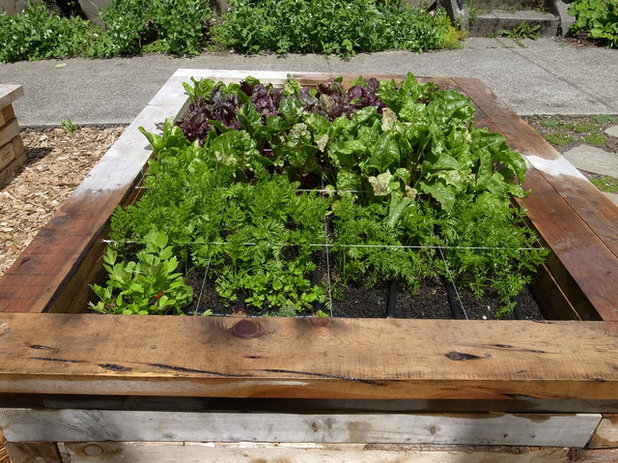
Erin Lau Landscape Design- Seattle
Soil. Fill your beds with high-quality soil.
All New Square Foot Gardening advocates a special mix, but any high-quality organic garden soil will work. In most cases, gardeners using the square-foot method will need to start out by purchasing soil. Once the beds are in place, additions of compost once or twice per year, along with a light sprinkle of granulated organic fertilizer at the time of each planting, should be sufficient to keep things going.
Markers. Finally, add your square-foot grid markers. Wooden markers are strong and durable. Alternatively, you can use string to mark your squares. Simply add a nail every foot along the wooden frame of your raised bed to secure the string.
While square-foot gardening was originally developed to have markers at every foot, you may prefer a different size. For medium-size gardens, 1-by-2-foot rectangles can be an excellent option, allowing for a simpler and potentially easier-to-manage design.
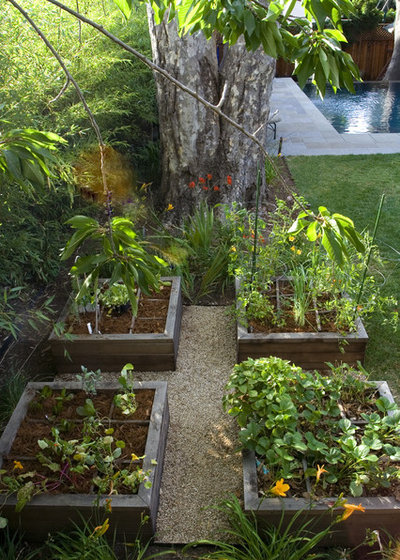
Shades Of Green Landscape Architecture
Planting. Once your garden is set up, start planting. Square-foot gardeners are advised to sow seeds lightly, minimizing the need to thin seedlings later. Rather than sprinkling seeds liberally, poke small holes in the soil at the recommended plant spacing and add just one or two seeds per hole. Or, to get even better use out of your space, start seeds in small containers and transplant the seedlings when they’re ready.
Begin by thinking about the biggest plant you plan to grow in your bed. For instance, if zucchini are in the picture, they’ll take up a large part of your bed when full-grown. From there, fill in your space with smaller plants. You can likely get a harvest or two of fast-growing baby lettuce in your bed before the zucchini get large.
If your garden has more than one bed, implement crop rotation to ensure plant health. For instance, if you have three beds, you may wish to plant tomatoes (a nightshade) in one, kale (a brassica) in another and cucumbers (a squash) in another. Between these large plants, smaller crops like lettuce can fill in the spaces. If you have only one bed, you’ll need to make choices about what to plant. Salad greens like lettuce, arugula and mustard are popular options for small gardens, as they take up little room, grow quickly and are very productive.
Create a patchwork effect by filling each square with a different plant. Consider combining companion plants for an attractive look that will help plants grow well. Be sure to label your plants clearly with plant markers.
As with any vegetable-gardening technique, it’s essential to plant your square-foot garden over time in order to ensure a long harvest window. Sow just a couple of squares each week, rather than planting up the whole bed at once. Once a square is ready for harvest, you can sow new seeds in the space left behind.
Keep in mind that even this user-friendly technique can take some practice to master, especially when it comes to understanding the correct plant spacing.
All New Square Foot Gardening is a very worthwhile read for those who wish to understand all the nuances involved. Practice and allow yourself to make mistakes. Modify things as needed to make them work for your style and needs.
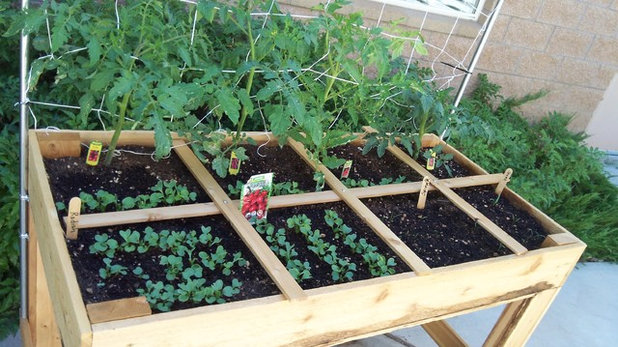
Garden Inspire
For urban dwellers. Balcony gardeners can still benefit from the principles of square-foot gardening. Consider using cedar planters or wine boxes that can be sectioned off. Alternatively, try thinking of each of your containers as its own “square foot.”
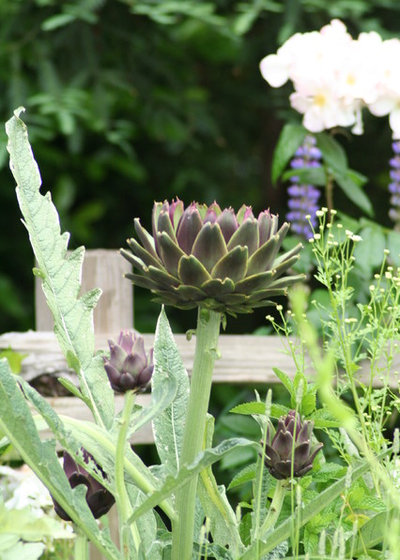
Terra Ferma Landscapes
Thinking outside the box. Square-foot gardening is ideal for quick successions of fast-growing annual vegetables, but it may not work for every situation. Perennial crops like asparagus and artichokes should have their own dedicated non-square-foot space, as should berries and fruits. Look at permaculture garden designs to learn how to design edible gardens that are way outside the box. If you have the space, consider creating a garden that has some square-foot beds and some wilder perennial areas, where native plants, pollinator-attracting flowers and perennial fruits can grow together in harmony.





